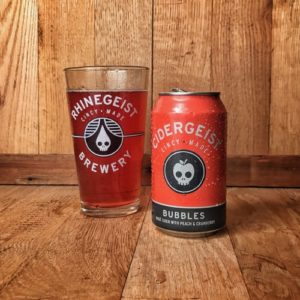I think that it’s safe to say that Rhinegeist’s Bubbles is what you might call a “smash hit”. As soon as they started serving it up around town on draft I immediately started hearing people talk about it, which was a new development for a cider in Cincinnati (for my ears), and one that I had to explore.
The Bubbles that I met was sweet, certainly full of apples and associated candy-like flavors, but on top of it all was a fruity juiciness that cut through the apple making it one of the best sweet ciders that I’d had before. It was worth what people were saying. (You can read my tasting notes here if you haven’t already)
 Bubbles – Meet Cans.
Bubbles – Meet Cans.
If you missed it (which I assume you did not) Rhinegeist got a lot of people pretty excited all at once this spring with the announcement that they’d be releasing a big Imperial IPA and Bubbles in cans at the same time. It covered two very different sides of their fans all in one fell swoop.
It wasn’t very long after that, though that Rhinegeist put a post on their Facebook page that shared a little bit of news – the post read:
Howdy!
We’ve got a transition happening this week. Bubbles is transitioning from a Rosé Cider to a Rosé Ale. The reason for this is that the old cider recipe classified Bubbles as a fruit wine which is subject to some pretty high taxes – so high that prices would hit $16.99 or more for six packs.
So, we made a very small adjustment to the recipe and, after extensively testing batches, we’ve made Bubbles Rosé Ale just as delicious – the flavor stays the same. Bubbles is still not gluten free (nor was the cider – though gluten levels are still quite low), and we’re hoping you enjoy it!
Happy Friday!
So… this answers a few of the main questions – like why did they change it to an ale? Is it any different? Will it mess with me if I have a gluten intolerance? That sort of stuff. I was curious though… I wanted to know more! So I dug in to figure out more details.
The Cost.
They were pretty upfront about the cost differences between doing it the way they were, and the way they are now. But what’s the actual numbers?
If you make a normal cider… fermented with apples, you’ll pay around $.24 per gallon. That’s what they were paying for it before, and what they pay for their other two ciders.
However… as soon as they added other fruit juices to it, they were making what the state classifys as a fruit wine, which commands somewhere around $.32 per gallon. That’s a hefty increase when you’re selling your six pack for $9.99.
If you change the recipe over into a beer… you are now dropping it into a third category (That’s a little more lenient) and your cost drops down to the neighborhood of $.16 per gallon… so it’s now even cheaper than it was before. Win Win!
 Are They Any Different?
Are They Any Different?
The brewery says that the two recipes taste the same. The new one only has a marginal amount of more gluten in it. To turn it into an ale, they presumably have to add some sort of grain… barley, corn, rice, wheat… something like that, so that’s where the gluten comes from. But do they actually taste the same? There was only one way to find out – As the recipe changed – I made sure to grab one of each to do a side by side tasting!
The first thing that I noticed about the two cans… now they don’t have to load up the beautiful design with nutritional information – which the artist inside of me appreciates being gone.
Keep in mind with this… my cider was a little bit older than my ale can… so that will play a small factor in the differences.
- The Cider is a hair darker than the Ale… this could be because of age?
- I most definitely get a bit more of an apple aroma from the cider.
- The Cider can comes across a little bit lighter and crisper than the Ale.
- There is a bit more of a head on the Cider… though not much more.
My take away is that I don’t think anyone will taste this and be mad that it’s very different. I’m also even more curious now about the taste differences that I found – and how many of them are related to my bias from knowing which was which, and how many of them came from the cans being different ages (they’re a couple months apart). The beer or cider… or whatever it is, is still delicious, and will keep it’s fans just as happy was they were when the cans were first released!
